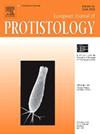大核和微核信息素基因的分析揭示了交配型遗传多样性的起源
IF 1.6
2区 生物学
Q4 MICROBIOLOGY
引用次数: 0
摘要
纤毛虫产生扩散的、细胞类型特异性的信息素来调节生长和交配。在Euplotes中,这些信号分子属于富含二硫化物和结构同源蛋白的物种特异性家族。信息素在体细胞微核(MAC)中共显性表达,而其等位基因多样性来源于种系微核(MIC)中的交配型位点。在性发育过程中,mic衍生的特定等位基因的多样性通过宏核注定序列(macronuclear -destined sequences, mds)组装进行重排。虽然许多MAC信息素被很好地表征,但它们的MIC前体和重排过程仍然未知。在这里,我们鉴定出了E. raikovi的两个MAC信息素基因(MAC -er-13/14),以及两个包含10个mds的MIC区域(共19 kb),这些mds组装成MAC -er-13。这些mds被内部消除序列(234-3345 bp)分开。最短的MDSs编码信息素分泌区(9-36 bp),较长的MDSs编码其他区域(44-419 bp)。考虑到分泌区具有较高的序列变异,而较短的mds具有较高的选择性加工或不精确组装的可能性,我们假设,大核信息素基因的高序列变异可能是由于这些较短的mds的选择性加工或不精确组装造成的,而这正是大核信息素基因大量交配类型的基础。本文章由计算机程序翻译,如有差异,请以英文原文为准。
Characterization of the macronuclear and micronuclear pheromone genes of Euplotes raikovi reveals the origin of the mating type genetic diversity
Ciliates produce diffusible, cell-type-specific pheromones to regulate growth and mating. In Euplotes, these signaling molecules belong to species-specific families of disulfide-rich and structurally homologous proteins. Pheromones are co-dominantly expressed by genes in the somatic macronucleus (MAC), whereas their allelic diversity originates from the mating type locus in the germline micronucleus (MIC). During MAC development in sexual process, the MIC-derived diversity of specific alleles is rearranged via macronucleus-destined sequences (MDSs) assembly. While many MAC pheromones are well characterized, their MIC precursors and rearrangement process remain unknown. Here, we identified two MAC pheromone genes (mac-er-13/14) of E. raikovi, and two MIC regions (19 kb in total) containing 10 MDSs that assemble into mac-er-13. These MDSs are separated by internal eliminated sequences (234–3345 bp). The shortest MDSs (9–36 bp) encode the secreted region of pheromone, while longer MDSs (44–419 bp) encode other regions. Considering that the secreted regions show a higher sequence variation and the shorter MDSs have higher probability of alternative processing or imprecise assembly, we hypothesize that the high sequence variability of the macronuclear pheromone genes, which underlies the large number of mating types in E. raikovi, may result from alternative processing or imprecise assembly of these short MDSs.
求助全文
通过发布文献求助,成功后即可免费获取论文全文。
去求助
来源期刊

European journal of protistology
生物-微生物学
CiteScore
4.60
自引率
20.70%
发文量
55
审稿时长
14.6 weeks
期刊介绍:
Articles deal with protists, unicellular organisms encountered free-living in various habitats or as parasites or used in basic research or applications. The European Journal of Protistology covers topics such as the structure and systematics of protists, their development, ecology, molecular biology and physiology. Beside publishing original articles the journal offers a forum for announcing scientific meetings. Reviews of recently published books are included as well. With its diversity of topics, the European Journal of Protistology is an essential source of information for every active protistologist and for biologists of various fields.
 求助内容:
求助内容: 应助结果提醒方式:
应助结果提醒方式:


